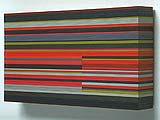We want other people's dreams
dal 13/2/2004 al 18/2/2004
Segnalato da
Carol K. Brown
Cedric Christie
Lili Fantozzi
Charlotte Marchand
Lawson Oyekan
Georges-Pascal Ricordeau
Sophie Smallhorn
Jeanne Susplugas
13/2/2004
We want other people's dreams
Galeriste sans galerie, Bruxelles
The exhibition invite you to investigate the other side of Brussels and come to discover eight contemporary artists in a unique converted warehouse.

Carol K. Brown, Cedric Christie, Lili Fantozzi, Charlotte Marchand, Lawson
Oyekan, Georges-Pascal Ricordeau, Sophie Smallhorn and Jeanne Susplugas
Vanessa Suchar invites you to investigate the other side of Brussels and come to discover eight contemporary artists in a unique converted warehouse
Vernissage: Saturday February 14th, 2004 from 2pm to 6 pm
The exhibition continues Sunday 15th, Monday 16th, Tuesday 17th and Wednesday 18th February 2004, from 2 to 8 pm or by appointment (please call Vanessa on 0494 421 735)
Once upon a time, the photograph was perceived as a visual truth. We knew
that paintings might lie, but never the camera. With the advent of computer
technology that permits the alteration of photographs, this myth has been
shown as the nonsense that artists knew all along. The acrylic paintings in
Carol K. Brown’s Encounters series seem “more real†than many photographs we
see in our daily lives, in spite of her obvious manipulation of realty. In
her work, Brown combines and alters multiple photographs, often of the same
person, and then meticulously reproduces them in paint. The resulting images
reflect relationships that never existed, but appear plausible, nonetheless.
The paintings seem photographic at first glance. They are small and upon
close inspection reveal the tiny brush strokes of acrylic paint.
Cedric Christie has been building a name for itself in contemporary art
circles with a number of well-received exhibitions since he gave up being a
car mechanic and turned his hand to art full time several years ago. From
snooker ball sculptures to monochrome portraits on solid aluminium, he sets
out to produce work, which is 'beautiful in its emptiness'. His sculptures
challenge the viewer to make sense of throwing away statements and intrigue
with their overlap of purpose - he uses colour for aesthetic satisfaction,
to update the monochrome tradition and to query the role of colour in pubic
culture. Cedric Christie appears courtesy of Rocket Gallery, London.
Lili Fantozzi’s work can be defined as kitsch, or recycling of consumer
societies outdates elements. Found in flea markets, attics and churches, the
Virgin Mary, Saints and sculptures of all origins are given a new life. Each
expresses her sensibilities. It is the need for open-mindedness, tolerance
and truth that feeds Fantozzi’s inspiration, paintings, and passion. The
kitsch art of happiness.
Comment mieux résumer le travail de Charlotte Marchand que par cette
phrase de F.Penelle: "auto détermination, force, déséquilibre, partout du
déséquilibre, une peinture sans béquilles, qui n’essaye pas de se tenir bien
droite". Cette peinture sans béquilles force le spectateur, pour le plus
grand plaisir de la démarche artistique, à se tenir bien debout devant la
toile et à y participer pleinement.
Life experience is considered as subject for Lawson Oyekan's work, the
creation of form, (socio-aesthetic -sculpture) realized in the
archaeological material clay, that is essentially the physicality shaped by
natural rigor of our psychic evolution. He often uses the naturally
choreographed drama of circumstances of society as subject of study and also
a starting point for the work. A form representing the state of man in our
society, and with particular emphasis on common faith and healing, for
example the realization of anaesthetic physicality of coming up for air is
best represented in clay.
Elizabeth Thomas says about Georges-Pascal Ricordeau, “Although his
reputation as an artist was growing, after a series of irreconcilable
difficulties, he found himself living in the streets of Paris with nothing
to his name. So, in this era of street culture, Ricordeau started to work
with what was available in that environment: street materials. He gleaned
whatever he could, recuperating things as commonplace and artistically
invisible as plastic bags, with supermarket or even luxury labels, and began
weaving them into cords. Later, the cord was formed into specific works...
the result of this recuperation is inspiringly fresh and even humorousâ€.
In her work Sophie Smallhorn explores colour, volume and proportion. The
forms of her wall works are small, simple, clean and geometric. Geometry and
saturated colour are centre stage in her compositions, combined and
contrasted depending on her intuitive sense of play. There is no theory,
science or system in her approach. Texture is not admitted - the chance
element of light and the controlled juxtaposition of form, volume, weight
and colour are all she requires to make these complex scenarios that are
journeys for the eye and mind.
Jeanne Susplugas comes back with her magical lens and macro photography,
on a new series. “Des photos s’enchaînent et défilent, affichant sous tous
les angles possibles deux corps imbriqués l’un dans l’autre. (…). Dans ces
photos, la véracité de l’apparence charnelle, est aussi illusoire. Ce ne
sont que des ébats de plastique, soulignant le caractère à la fois pervers
et bénin de gadgets à la physionomie plus vraie que nature. Le rose et les
poupées sont parfois trompeurs. Ne pas mettre à portée des enfantsâ€. She
will also be showing a video, in the cosy environment of a bedroom.
Le Salon for Art Collectors showcases international emerging artists in
private homes, an ideal setting that helps break through the many barriers
surrounding contemporary art. Le Salon provides a comfortable learning
environment, while letting art-enthusiasts imagine how a piece of art would
look in their own house. Prices are affordable and clearly marked, and the
atmosphere is without the pressures of a gallery.
For further information and images, please contact Vanessa Suchar at +32
(0)494 421 735
Galeriste sans galerie
Rue des Ailes, 10- Brussels, 1030, Belgium



